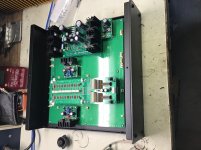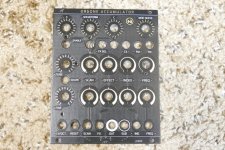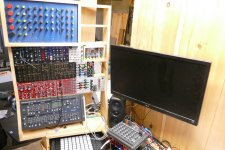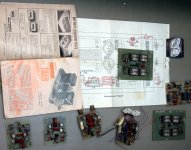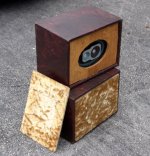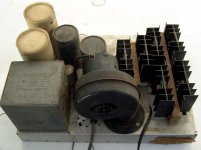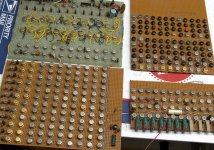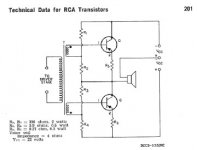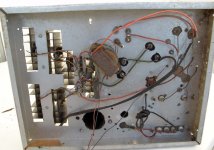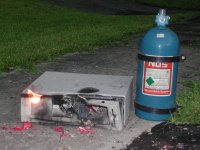Most Class A amps I have build in the past operated at class A to a point and then moved into AB. I kind of assumed that was the way it was until I built the Alpha Nirvana and it clipped at the end of the road. Truth be known in normal listening I have never seen the clip light flash. From a listening perspective while each amp had their own sound character I don’t think it was from its ability to transition to AB or remain in class A and clip as it is many other design considerations. Ti’s amps always sounded good and I thought they were sensibly designed from the component availability and technology available at the time. Now their are so many more choices and some good components going away I think their are even more opportunity for unique designs. I really appreciate all the good stuff X puts out, if I only build a few pieces I read up on most stuff he builds.
Thanks
Bill
Thanks
Bill
On the bench, not just today but throughout November and Christmas month:
1. Single-Ended Triode Tube Amp (George's SSE). General maintenance and upgrades. A couple of parts will be ordered for the PSU.
2. Old Solid-State Panasonic receiver. Uses modules with a bunch of MOSFETs. Checking whether it gets an overload condition or if it is overheating somewhat.
3. Low-voltage tube preamp experiments. It's easy to make a guitar amp like that (distortion is included), but hard to make a usable audiophile one. I have a few different wiring schemes to test here. Wired breadboard wires to sockets for easy breadboarding. Any mistake I make are at really low voltage so I am not concerned about breaking anything here.
4. High-voltage Tube preamp prototype. The challenge is to build this only with things I have lying around. The design could be a bit modular in the sense that I'd like to have add-ons for guitar distortion or for tone controls but also have a true bypass when these aren't needed (in audiophile usage). Need to brush up on interfacing directly with DACs and Phono.
5. Solid-State Headphone Amp prototype. The design is already settled: the simplest single-ended that can wow someone not used to really good sound, fewest parts possible, making it easy to swap for better or alternate parts. Of all things bugging me about it right now is finding a good way to make the front and back panels...
6. Surround Home Theater: rebuilding one around a new Dolby Atmos receiver. This will be a purchase. I don't foresee any Electronics here though.
Edit: I forgot to add: I have a few more projects: one is a cross-over, another one is a mono monitoring open baffle with a single full-range driver that I salvaged, and more but these may not be for this holiday period, most probably later or much later, like next Winter or further down the line. The bizarre impedance profile of speaker drivers is bugging me...
Plate full => Happiness.
1. Single-Ended Triode Tube Amp (George's SSE). General maintenance and upgrades. A couple of parts will be ordered for the PSU.
2. Old Solid-State Panasonic receiver. Uses modules with a bunch of MOSFETs. Checking whether it gets an overload condition or if it is overheating somewhat.
3. Low-voltage tube preamp experiments. It's easy to make a guitar amp like that (distortion is included), but hard to make a usable audiophile one. I have a few different wiring schemes to test here. Wired breadboard wires to sockets for easy breadboarding. Any mistake I make are at really low voltage so I am not concerned about breaking anything here.
4. High-voltage Tube preamp prototype. The challenge is to build this only with things I have lying around. The design could be a bit modular in the sense that I'd like to have add-ons for guitar distortion or for tone controls but also have a true bypass when these aren't needed (in audiophile usage). Need to brush up on interfacing directly with DACs and Phono.
5. Solid-State Headphone Amp prototype. The design is already settled: the simplest single-ended that can wow someone not used to really good sound, fewest parts possible, making it easy to swap for better or alternate parts. Of all things bugging me about it right now is finding a good way to make the front and back panels...
6. Surround Home Theater: rebuilding one around a new Dolby Atmos receiver. This will be a purchase. I don't foresee any Electronics here though.
Edit: I forgot to add: I have a few more projects: one is a cross-over, another one is a mono monitoring open baffle with a single full-range driver that I salvaged, and more but these may not be for this holiday period, most probably later or much later, like next Winter or further down the line. The bizarre impedance profile of speaker drivers is bugging me...
Plate full => Happiness.
Last edited:
Nice list of projects you habve there YashN! Will keep you busy for sure.
If I can interest you in some great sounding simple SS amps, check out the Fistful of Solder thread...
Use a PCB maker and make black solder mask PCBs (if that is color you like) and the copper planes provide nice shielding. Holes are precise and silkscreen makes perfect labels. Very inexpenisve to do at JLCPCB.
If I can interest you in some great sounding simple SS amps, check out the Fistful of Solder thread...
Of all things bugging me about it right now is finding a good way to make the front and back panels...
Use a PCB maker and make black solder mask PCBs (if that is color you like) and the copper planes provide nice shielding. Holes are precise and silkscreen makes perfect labels. Very inexpenisve to do at JLCPCB.
Last edited:
Nice list of projects you habve there YashN! Will keep you busy for sure.
You're too kind: these are simple projects that bring some DIY joy while I am mostly inside rather than in the forthcoming Canadian snow. Thank you.
I did do some quite more spectacular progress on clean power supply during lockdown, so I'll probably add this to the projects as well. I am doing solely Linear Regulated PSUs for my builds. I am also considering some battery, portable builds and if I can get a little charger included, that would be great.
If I can interest you in some great sounding simple SS amps, check out the Fistful of Solder thread...
I was thinking op amps and was going to leave FETs for later, but I really like the harmonic profile here! Ha, I may add this to my list this Winter then, and Digikey should provide the goods. This reminds me a little of the zen-quality of some of Nelson's DIY circuits and I'd really like to delve into those too. Thanks again.
Use a PCB maker and make black solder mask PCBs (if that is color you like) and the copper planes provide nice shielding. Holes are precise and silkscreen makes perfect labels. Very inexpenisve to do at JLCPCB.
Definitely a great idea. Do we go for double-sided here for better shielding or is a single side enough? I may have seen a pic of it yesterday, might even be your post - it does look super sleek in black. I just need to find a way to fasten the front and back panel to the rest (picture an external PC CD/DVD Player case without the front and back). Triple thanks.
I took some time to maintain and upgrade the Simple Single-Ended Triode Tube Amplifier yesterday. It feels good
Last edited:
If you are into clean low noise linear supplies, check out the SLB thread. Active bridge, CRC, cap Mx. Is able to provide continuous 4A current with about 1mV rms ripple at 38v.
What's on my bench? Well, mostly parts of the bench itself and the second bench.
I built a pair of benches six years ago when I moved into this house. All of the materials used were salvaged from the dumpster that the house builder used, and some wood flooring samples from a defunct flooring shop.
I recently decided to change a few things, and add some additional bracing. That snowballed into a something closer to a full lab makeover, which I'm still in the middle of.
I have lots of unfinished projects and a serious state of disorganization, which is getting fixed. One of my unfinished projects is a modular music synthesizer, but by its nature, will never be completely finished.
Here is a picture of the faceplate for one of the modules. It is a PCB with gold runners, and white silkscreen. I plan to try this on some of my own module designs. Blue, white and gold looks nice too, but some blue solder mask fades pretty quickly under UV or sunlight.
I built a pair of benches six years ago when I moved into this house. All of the materials used were salvaged from the dumpster that the house builder used, and some wood flooring samples from a defunct flooring shop.
I recently decided to change a few things, and add some additional bracing. That snowballed into a something closer to a full lab makeover, which I'm still in the middle of.
I have lots of unfinished projects and a serious state of disorganization, which is getting fixed. One of my unfinished projects is a modular music synthesizer, but by its nature, will never be completely finished.
Here is a picture of the faceplate for one of the modules. It is a PCB with gold runners, and white silkscreen. I plan to try this on some of my own module designs. Blue, white and gold looks nice too, but some blue solder mask fades pretty quickly under UV or sunlight.
Attachments
I love modular synthesizers!
I was intrigued by the early synths
My first synth was a crude, small "modular," A PAIA 2700 that used shirt buttons for a keyboard. I ordered the kit in 1970 or 1971 and it took about a year to get all of the modules. Next, I designed and built my own digital synth in 1971 and got sound out of it in 1972. It used primitive RTL logic chips since I had obtained hundreds of them by dumpster diving behind the Coulter Electronics plant in Miami.
In 1973 I started my 41 year career at Motorola where I made good money, so the DIY stuff morphed into a rack full of ARP and Korg analog goodies, which I stupidly sold for pennies in the digital 80's.
Now I'm building a mix and match collection of analog, digital, and mixed mode synthesizers. Some even have vacuum tubes. Here is a picture of the incomplete modular. Some of the "modules" are Behringer clone synths, and the two with wood frames are DIY digital synths of my own design. Both are Teensy powered. "Blue" is a digital mono synth, and the tiny synth to Blue's lower right is three synths in one small battery powered box, each with 6 voice polyphony.
On yet another bench is a pile of Eurorack modules, each in some stage of partial assembly.
Attachments
As a kid I rode my bicycle to the local trash dump to get part for my DIY electronics experiments. There were lots of TVs, radios, and sometimes HiFi sets full of tubes, transformers, and other parts, all for free.
As a teenager a friend who had a car introduced me to the fine art of dumpster diving. There was a row of import houses, most noticeably Pearce Simpson (CB sets) and Julliette (cheap radios, cassette players, and HiFi sets). We would load up an El Camino full of trash and make good units from multiple dead or damaged units. We sold this stuff at school or a local flea market to fund our DIY habits. There were lots of medium sized electronics factories around the Miami area in the 60's and early 70's. Some like Coulter (medical electronics) Simpson (marine electronics) Milgo (huge XY plotters) tossed their scrap boards, from which we extracted parts using a propane torch.
In 1973 I started at a newly built Motorola plant about 35 miles north of where I grew up on the assembly line. In 2014 I took a buyout leaving as a "Principal Staff Research Engineer" having two engineering degrees paid for by Motorola. Who works at the same place for 41 years any more? Is that even possible today?
The synth I built with all those RTL chips was destroyed when I left home under less than optimum circumstances. I did manage to save some of the boards that I had spent far too much time making. I still have them, and may try to power some up, if I can remember enough of what I did over 50 years ago to do so without making smoke. Note the 1960's date codes on the chips.
Also seen is a big solid state amp I made in high school. It used 6 X mystery transistors also from someone's trash to make 200+ watts on 100 volts into 4 ohms at an untold amount of THD. As a teenage guitar player, my motto was "If you can't be good, be LOUD." I found it in my warehouse during a clean up before leaving Florida. It blew a fuse when I plugged it in, so I jumped the fuse and watched some vintage caps spew their guts. I kept the heat sinks and tossed the rest.
Did I make speakers in the mid 70s? Again, trash was involved. The materials used were from the dumpster behind a bean bag chair and waterbed factory. The drivers came from the going out of business sale at a local K-mart. After finding them in the warehouse cleanout, they met their fate at the hands of my guitar playing. That old blue foam surround didn't last long.
Working at Motorola got us free silicon just by filling out a sample request form. In the 70's we cloned every SWTPC "Tiger" amp that existed. We cloned the SWTPC computer too. The date codes on those MJ802's and MJ4502's reveal that they are from 1973.
As a teenager a friend who had a car introduced me to the fine art of dumpster diving. There was a row of import houses, most noticeably Pearce Simpson (CB sets) and Julliette (cheap radios, cassette players, and HiFi sets). We would load up an El Camino full of trash and make good units from multiple dead or damaged units. We sold this stuff at school or a local flea market to fund our DIY habits. There were lots of medium sized electronics factories around the Miami area in the 60's and early 70's. Some like Coulter (medical electronics) Simpson (marine electronics) Milgo (huge XY plotters) tossed their scrap boards, from which we extracted parts using a propane torch.
In 1973 I started at a newly built Motorola plant about 35 miles north of where I grew up on the assembly line. In 2014 I took a buyout leaving as a "Principal Staff Research Engineer" having two engineering degrees paid for by Motorola. Who works at the same place for 41 years any more? Is that even possible today?
The synth I built with all those RTL chips was destroyed when I left home under less than optimum circumstances. I did manage to save some of the boards that I had spent far too much time making. I still have them, and may try to power some up, if I can remember enough of what I did over 50 years ago to do so without making smoke. Note the 1960's date codes on the chips.
Also seen is a big solid state amp I made in high school. It used 6 X mystery transistors also from someone's trash to make 200+ watts on 100 volts into 4 ohms at an untold amount of THD. As a teenage guitar player, my motto was "If you can't be good, be LOUD." I found it in my warehouse during a clean up before leaving Florida. It blew a fuse when I plugged it in, so I jumped the fuse and watched some vintage caps spew their guts. I kept the heat sinks and tossed the rest.
Did I make speakers in the mid 70s? Again, trash was involved. The materials used were from the dumpster behind a bean bag chair and waterbed factory. The drivers came from the going out of business sale at a local K-mart. After finding them in the warehouse cleanout, they met their fate at the hands of my guitar playing. That old blue foam surround didn't last long.
Working at Motorola got us free silicon just by filling out a sample request form. In the 70's we cloned every SWTPC "Tiger" amp that existed. We cloned the SWTPC computer too. The date codes on those MJ802's and MJ4502's reveal that they are from 1973.
Attachments
Last edited:
Late 60 early 70s I lived in Saint Joe, Benton Harbor Michigan. They used to sweep the floors at the Heathkit plant and donate the parts to my high school electronics class. Then I used to fly model planes with the engineers. It was my introduction to electronics. I would ride my bike down to the show room floor and drool over the ham radio stuff. They finally let me build stuff to proof read their manuals but after about 25 kits they felt I was not representing their average builder. Finally got my general ticket a few years back, kind of anticlimactic.
My high school electronics class got its part from Homestead Air Force Base. Lots of tube stuff, no solid state. Oddly the training manuals were from the US Navy.
One of my hangouts as a kid was the Lafayette Radio Electronics store, as they let me play the guitars and talk on the CB radio.
In the mid 80's I got a Novice ham ticket with the call sign KB4LRE, which I promptly upgraded to a technician class. That became a tech-plus in the 90's when the tech license lost the code requirement. In the mid 2000's I upgraded to extra class, but I still have the old novice call sign since the randomly assigned call reminded me of the childhood hangout that got me into two-way radio originally.
One of my hangouts as a kid was the Lafayette Radio Electronics store, as they let me play the guitars and talk on the CB radio.
In the mid 80's I got a Novice ham ticket with the call sign KB4LRE, which I promptly upgraded to a technician class. That became a tech-plus in the 90's when the tech license lost the code requirement. In the mid 2000's I upgraded to extra class, but I still have the old novice call sign since the randomly assigned call reminded me of the childhood hangout that got me into two-way radio originally.
I love these stories guys! An amazing life experience you are sharing here. Please keep this coming!

Got to love the centrifugal blower assisted Class A amp here!
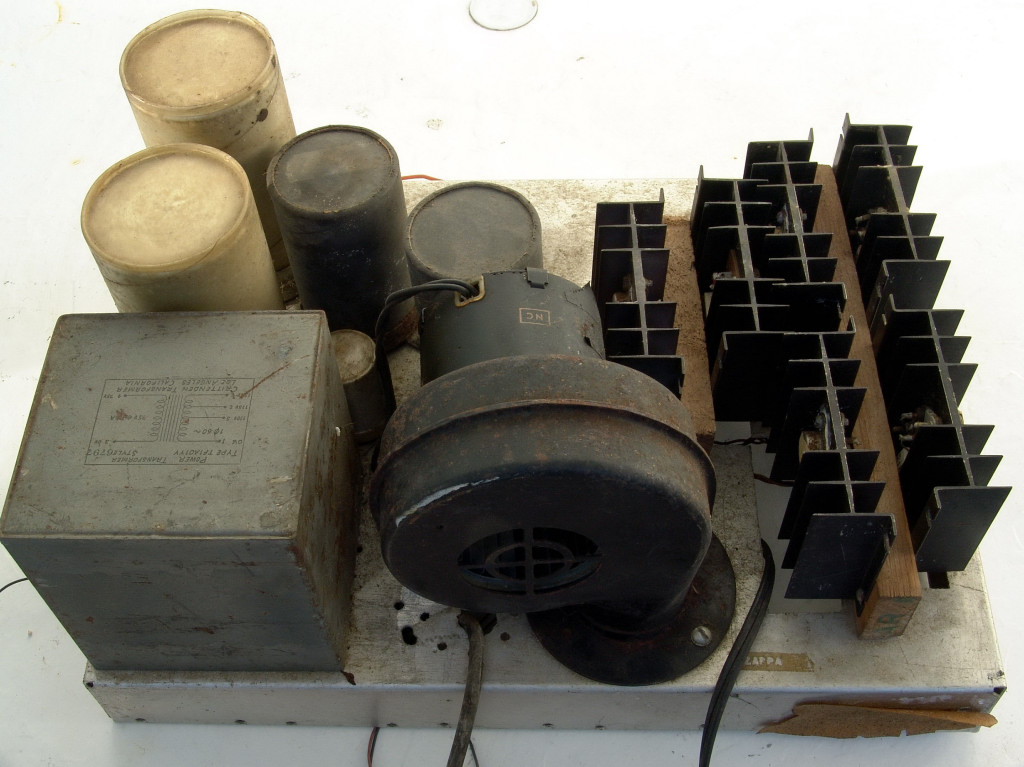
Took me a second to realize that the air gets pumped into the hollow base and exits the cutouts below the heatsink fins! Cool.
You were way ahead of guys using Noctua fans on CPU coolers.

Got to love the centrifugal blower assisted Class A amp here!
Took me a second to realize that the air gets pumped into the hollow base and exits the cutouts below the heatsink fins! Cool.
You were way ahead of guys using Noctua fans on CPU coolers.
Last edited:
Realize that I built this at age 16 with only a hand drill and a nibbling tool. My construction practices have improved slightly in the 50+ years since then. You are looking at the better side in the previous post. The underneath is a bit uglier. This amp probably last saw power in the mid 70's. It had been stashed in a non climate controlled warehouse in south Florida since the early 80's.
This is far from a class A amp. It used the transformer driven totem pole output topology that was commonly seen in 1960's solid state amps. I wound the driver transformer myself on the core of an old filament transformer. The amp ran close to class B, but saw duty as a guitar amp, and as the PA for a rock band, hence the cooling requirements. For guitar amp duty I drove this "booster amp" directly from the speaker output of a 5 watt DIY vacuum tube guitar amp. For PA duty the driver was an old vacuum tube Bogen PA amp, or a Fender solid state PA amp.
The enclosed schematic from an old RCA transistor manual (I think) shows the basic topology I used. I did not have a split supply, so I used the two black caps to feed the speakers. The transistors were NPN silicon parts so the polarity is reversed from the schematic. Depending on intended use, sometimes I slowed the blower down by running it from the power transformer secondary which was 75 volts.
This is far from a class A amp. It used the transformer driven totem pole output topology that was commonly seen in 1960's solid state amps. I wound the driver transformer myself on the core of an old filament transformer. The amp ran close to class B, but saw duty as a guitar amp, and as the PA for a rock band, hence the cooling requirements. For guitar amp duty I drove this "booster amp" directly from the speaker output of a 5 watt DIY vacuum tube guitar amp. For PA duty the driver was an old vacuum tube Bogen PA amp, or a Fender solid state PA amp.
The enclosed schematic from an old RCA transistor manual (I think) shows the basic topology I used. I did not have a split supply, so I used the two black caps to feed the speakers. The transistors were NPN silicon parts so the polarity is reversed from the schematic. Depending on intended use, sometimes I slowed the blower down by running it from the power transformer secondary which was 75 volts.
Attachments
Last edited:
Haven't seen an amp with a turbo on it before!
Or a PC with Nitrous Oxide Injection......it overheated a bit.
I was also known for some serious DIY fireworks on New Years Eve and the 4th of July in Florida. After the 911 2001 incident I was told by a friendly cop that my antics would no longer be overlooked, so no more big "firecrackers." In 2002 we looked for legal ways to make a racket.
After unsuccessfully attempting to grenade a lawnmower engine on NOS (it screamed for a while, then slowed down and seized), we stuffed a dead computer full of fireworks and ran the nitrous hose into the back of it. We lit off the fireworks, then turned on the gas. There was no big bang, but we did have a mess to clean up afterwards. It burned for about 10 minutes after removal of the NOS and the black spot on the sidewalk lasted for months.

